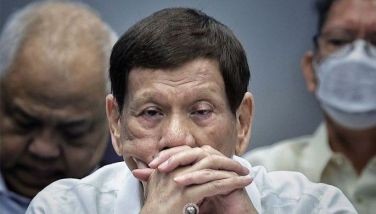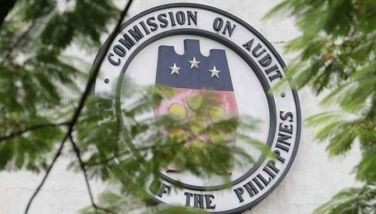What we know so far: PLDT’s petition to remove Makati building as important cultural property

MANILA, Philippines — During National Heritage Month, the National Commission for Culture and Arts informed the public that Philippine Long Distance Telephone (PLDT) Inc. requested the removal of the presumption of Ramon Cojuangco Building (RCB), a work of late National Artist for Architecture Leandro V. Locsin, as an important cultural property.
The NCCA made this announcement on Tuesday, May 17, via a notice to the public.
The RCB, located along Dela Rosa Street, corner Makati Avenue, Legaspi Village, in Makati City, was designed by Locsin in 1974 as commissioned by PLDT Inc., formerly the Philippine Long Distance Telephone Company. The 15-story structure, housing the offices of the telco firm, bears the “International Style with exposed aggregate finish.”
It was completed eight years later and inaugurated in 1982. The building has a roof deck, podium garden and three basement levels.

By virtue of Republic Act No. 10066 or “National Cultural Heritage Act,” RCB is a presumed important cultural property (ICP) because it is a work of a national artist. It was also included in the Philippine Registry of Cultural Property (PRECUP), or the repository of all information pertaining to cultural properties in the Philippines deemed significant to our cultural heritage.
The same law states that “the property owner may petition the appropriate cultural agency to remove the presumption of important cultural property which shall not be unreasonably withheld.”
This provision prompted PLDT to file with the NCCA the petition that seeks to delist the RCB from the ICPs. The telco firm cited the following grounds:
- The RCB does not demonstrate exceptional cultural, artistic, and historical significance. Thus, it cannot be regarded as an ICP.
- The actual condition of the RCB considerably differs from the distinctive style of L.V. Locsin
“The RCB does not represent the iconic works of Locsin. The RCB is generic, nondescript, and purged of any references to local culture, tradition, climate, or identity of the place,” the petition reads, explaining the first ground.
Among the popular buildings Locsin designed include the Manila International Airport now known as the Ninoy Aquino National Airport Terminal 1, Cultural Center of the Philippines, Folk Arts Theater, Philippine International Convention Center, The Westin Hotel now known Sofitel Philippine Plaza, among others.
Heritage assessment report
In March this year, Arc Lico International Services Corporation, headed by renowned architect and heritage conservationist Gerard Lico, released a 60-page Technical and Heritage Assessment Report on the RCB with 36-page annexes.
The independent report, made publicly available by the NCCA, evaluated the historical; scientific and intellectual; social and cultural significance of RCB, now a known landmark in Makati City.

The architectural firm charted the genealogy of Locsin’s architectural formalistic lineage and assessed that RCB does not represent Locsin’s work. It cited that the building “deviates greatly from the typical and iconic design intent of Locsin.”
The report found that there was a contrast between the contemporary, dated and original design elements, reflecting the evolving taste and ideas of productivity and the corporate image of the structure.
“In its present state and in the context of assessing its heritage and cultural significance, the Ramon Cojuangco Building failed to demonstrate architectural and stylistic rarity, techno-scientific innovation, physical integrity and the fundaments of Filipino identity,” the report read.
“Much more, there have been no associated historical events and cultural practices that [emanate] from the building or took place within its premises. The building does not embody a distinctive type, period style, method of construction or scientific architectural innovation,” it added.
According to the report, among the key spaces that would have shown Locsin’s architectural prowess are unrecognizable. They said that the main lobby and executive offices are not attributable to his style.
“It can be argued that Locsin is well remembered for his mastery of concrete—buoyancy, lightness, soaring forms, and massive geometries; but these qualities are poorly represented in the Ramon Cojuangco Building,” the assessment report reads.
“Therefore, with the findings of this report, without diminishing the talent and genius of National Artist for Architecture Leandro V. Locsin, we conclude that the Ramon Cojuangco Building, completed in 1982 for the Philippine Long Distance Telephone Company, does not represent the artistic merits of Locsin’s oeuvre, and is of negligible cultural, scientific, or social significance,” it concluded.
NCCA’s ocular inspection of RCB
On May 10, the NCCA released a report on the conducted ocular inspection of RCB. This was prepared by Lawrence Manipol, project officer of the Declaration and Public Heritage Section of the Cultural Properties Protection and Regular Division (CPPRD) and Jeanne Therese Maling, researcher at CPPRD.
In its report, the commission said it received PLDT’s petition dated April 4, 2022 on April 12, 2022. The telco firm cited the similar grounds of Locsin’s working having failed to demonstrate its cultural, artistic and historical significance and the building having differed from the architect’s distinct style.
PLDT said it wants to embark on its more than 90-year-history by transforming and redeveloping its main offices housed in RCB.
“As the country's leading, dynamic, and customer-centric multimedia organization, Petitioner intends to redevelop and transform its main offices, the Ramon Cojuangco Building, into a modern, ecologically sustainable, and open campus-type headquarters for the strategic purpose of promoting collaboration, agility, and efficiency among PLDT's business units and allowing PLDT to effectively respond to constantly evolving customer needs and a hyper-competitive landscape,” the petition reads.
“Before it can embark on this significant milestone in its more than 90-year history, Petitioner is required by law to obtain the approval of the National Commission for Culture and the Arts (the "NCCA” or the "Commission") to remove the RCB's status as an Important Cultural Property ("ICP"),” it added.
PLDT’s legal team also raised that the ICP presumption is “disproved by inconvertible proof.”
Following the receipt of PLDT’s petition, the NCCA conducted an on-site assessment of RCB on May 5.
“The NCCA personnel met with the PLDT Corporate Affairs & Legal Services team and their consultants, and explained to them the processes that the petition will undertake,” the report said.
During their visit, the NCCA determined that the main changes of the building are in the interiors, fixtures, furniture, finishes, exterior paint and flooring.
“L. V. Locsin's language is evident in the floating effect characteristic of RCB, as seen in multiple floating planes of its exterior. Further, the multiple floating planes in the exterior of the building remain unchanged, indisputable of its truncated or chamfered design at the bottom. There are no remarked alterations of fenestration design throughout the structure that would affect its floating effect attributes,” the NCCA found.
“While the original beton brut design is voided by the introduction of paint, nonetheless, this does not posit that the structure is not reflective or has diminished L. V. Locsin's style,” it added.
In view of this, the NCCA concluded that despite some changes in the buildings that were uncharacteristic of Locsin. These are reversible.

“In summation, the RCB has gone through several interventions over time in its exterior facades and interior spaces, nevertheless, these are reversible and can be returned to the original finishing,” the NCCA ended its report.
Mixed reactions to PLDT’s petition
Meanwhile, as the NCCA issued a notice to the public. Several Filipinos aired their thoughts on the proposed removal of the Makati building as an ICP.
Some agreed with PLDT’s petition and said that not all works of national artists must be preserved.
“Hindi porke’t gawa ng National Artist, para na lang tayong asong tutungo-tungo na automatic maganda na ito,” a Facebook user commented.
(Just because it is a work of a National Artist, we should bow down like a dog and agree that it is automatically appealing)
He also said that the building is not apt for the current hyper-accelerated market and functionality of the building.
“Hindi na rin ito sustainable. Naka-indicate naman sa petition ng PLDT ito. Na-allude naman din ito sa Arc Lico report, example sa need palitan ang toilet,” the Facebook user said.
(It’s also not sustainable. It was stated on PLDT’s petition. It was also alluded to in the Arc Lico report, for example, the need to replace the toilet.)
“Nothing exemplary naman talaga sa itsura ng building. (There’s nothing exemplary in the building design.) Nothing exceptionally ‘Filipino’ at all,” he added.

Others disapprove of the telco firm’s petition and lamented that it was filed during National Heritage Month.
A Facebook user cited that there are several buildings not designed by national artists that were demolished before the 50th year to avoid the heritage law.
“Ortigas, Benpres, BPI, many others. Tapos isusunod ang Ramon Magsaysay High School. Naging bagong kalakaran na talaga ang 49-year-old ‘artificial retirement age’ ng mga building, maiwasan lang ang NCCA designation. Save that building, or else kung hindi magustuhan ng PLDT ang desisyon ng NCCA, just sell it to other owners who are very willing to preserve it,” he said.
(Ortigas, Benpres, BPI, many others. And then next is the Ramon Magsaysay High School. The 49-year-old ‘artificial retirement age’ of buildings has become the new norm to avoid the NCCA designation. Save that building, if the PLDT will not agree with the decision of NCCA, just sell it to other owners who are very willing to preserve it)
Society and culture website Brutalist Pilipinas also wrote to NCCA to oppose PLDT’s petition. It called the plea a “bald request to devalue the work of a national artist.”
“As an artist and educator, I would like to register my opposition and disappointment. The Filipino people have already lost a string of Locsin buildings in recent years: the Mandarin Oriental, the BDO Corporate Center, and soon, the Folk Arts Theater, among others. What then is the value of declaring him National Artist if the state will do nothing to preserve his body of work for future generations?” Karl Castro, research head, wrote.
Castro called on the NCCA to preserve not just the works of Locsin but also other national artists.
“I pray that the NCCA will do more to preserve the works of Locsin and all of our other national artists, in whatever form necessary. For architectural works, this means exhaustive and sensitive preservation so that they will remain a part of our built landscape,” Castro said.
The NCCA is giving any person who is affected by PLDT’s petition to file their written support or opposition until June 7, 2022.
They may send their letters to [email protected].
- Latest
- Trending

































